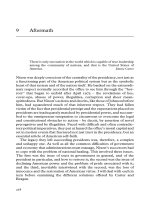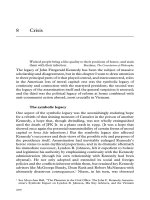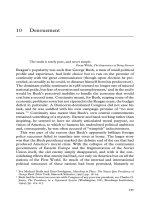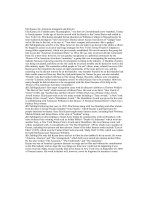The transformation of the American class structure, 1960-1990
Bạn đang xem bản rút gọn của tài liệu. Xem và tải ngay bản đầy đủ của tài liệu tại đây (72.99 KB, 11 trang )
3. The transformation of the American
class structure, 1960±1990
Two opposed images have dominated discussions of the transformation
of class structures in developed capitalist societies. The ®rst of these is
associated with the idea that contemporary technological changes are
producing a massive transformation of social and economic structures
that are moving us towards what is variously called a ``post-industrial
society'' (Bell 1973), a ``programmed society'' (Touraine 1971), a ``service
society'' (Singelmann 1978; Fuchs 1968) or some similar designation. The
second image, rooted in classical Marxist visions of social change, argues
that in spite of these transformations of the ``forces of production,'' we
remain a capitalist society and the changes in that class structure thus
continue to be driven by the fundamental ``laws of motion'' of capit-
alism.
The post-industrial scenario of social change generally envisions the
class structure becoming increasingly less proletarianized, requiring
higher and higher proportions of workers with technical expertise and
demanding less mindless routine and more responsibility and knowl-
edge. For some of these theorists, the central process underwriting this
tendency is the shift from an economy centered on industrial production
to one based on services. Other theorists have placed greater stress on
the emancipatory effects of the technical±scienti®c revolution within
material production itself. In either case the result is a trajectory of
changes that undermines the material basis of alienation within produc-
tion by giving employees progressively greater control over their condi-
tions of work and freedom within work. In class terms, this augurs a
decline in the working class and an expansion of various kinds of expert
and managerial class locations.
The classical Marxist image of transformation of class relations in
capitalism is almost the negative of post-industrial theory: work is
56
becoming more proletarianized; technical expertise is being con®ned to a
smaller and smaller proportion of the labor force; routinization of
activity is becoming more and more pervasive, spreading to technical
and even professional occupations; and responsibilities within work are
becoming less meaningful. This argument was most clearly laid out in
Braverman's (1974) in¯uential book, Labor and Monopoly Capital. The
basic argument runs something like this: because the capitalist labor
process is a process of exploitation and domination and not simply a
technical process of production, capital is always faced with the problem
of extracting labor effort from workers. In the arsenal of strategies of
social control available to the capitalist class, one of the key weapons is
the degradation of work, that is, the removal of skills and discretion
from direct producers. The result is a general tendency for the proletar-
ianzed character of the labor process to intensify over time. In terms of
class structure, this implies that the working class will tend to expand,
skilled employees and experts decline, and supervisory labor to increase
as the demands of social control intensify.
This chapter attempts to use quantitative data on the changes in
distributions of people in the American class structure from 1960 to 1990
as a way of intervening in this debate. In section 3.1 I will lay out a series
of alternative hypotheses about the expected changes in different class
locations based on the arguments of post-industrial theory and tradi-
tional Marxist theory. Section 3.2 will explain the empirical strategy we
will adopt. Section 3.3 will then present the basic results.
3.1 Contrasting expectations of post-industrial and Marxist theory
The debate between post-industrial and Marxist conceptions of social
change can be seen as a set of competing claims about the relative
expansion and contraction of different locations within the class struc-
ture.
The classical Marxist theory of capitalist development posits three
trends which directly affect the class distribution of the labor force. First,
the expansion of capitalism tends to destroy independent, self-employed
producers. In the nineteenth century and the ®rst half of the twentieth
century this process massively affected self-employed farmers in the
agricultural sector, but the process is a general one affecting all sectors of
the economy. This yields the prediction of a steadily declining petty
bourgeoisie. Second, the dynamics of capital accumulation tend to
generate increasing concentration and centralization of capital as small
57American class structure, 1960±1990
capitalist ®rms are destroyed and larger ®rms grow. This trend yields the
prediction of a decline in small employers and an expansion of man-
agers, especially expert managers, to staff the administrative bureau-
cracies of corporations. Third, as noted above, in order to increase
control over the labor force and the extraction of labor effort, capitalists
have an incentive to reduce the autonomy of skilled labor and, where
possible, replace skilled with unskilled labor. This, in turn, requires an
expansion of the social control apparatus within production to monitor
and supervise workers increasingly deprived of a knowledge about
production. The appropriation by management of knowledge from
skilled workers should also lead to the expansion of the expert-manager
category. These trends of intensi®ed proletarianization in the labor
process generate the prediction of an expansion of the working class, an
expansion of supervisors, managers and expert-managers, and a decline
of (nonmanagerial) experts and skilled workers.
Post-industrial theory does not contain a systematic a set of hypoth-
eses about transformations of the petty bourgeoisie and small employers,
and therefore I will not impute formal predictions for these categories.
The expectations for the changes in various categories of employees can
be more clearly derived from the logic of post-industrialism. The
expectation in post-industrial theory of a world of work with much more
self-direction and autonomy than industrial capitalism suggests the
prediction of a relative decline in purely supervisory labor (i.e. positions
of social control within work which are not part of the managerial
decision-making apparatus). On the other hand, managerial positions
would be expected to increase as the complexity of organizations and
decision-making increases.
Where post-industrial theory differs most sharply from the Marxist
arguments outlined above is in the predictions about experts, skilled
workers and workers. As a concomitant of the move to a knowledge-
and service-based economy, post-industrial theorists would generally
expect a pervasive expansion of jobs requiring high levels of expertise
and autonomy. This implies a process of gradual deproletarianization of
labor in which there was steady expansion of the expert and expert-
manager class location and a corresponding decline of the core working
class. Insofar as manual labor is still required, it would have an increas-
ingly skilled and technical character to it, and thus highly skilled
workers should also expand. The basic hypotheses of Marxist and post-
industrial perspectives are summarized in Table 3.1.
Class counts58
3.2 Methodological strategy
The analytical technique used in this chapter is sometimes referred to as
``shift/share'' analysis (Wright 1997: 97). This procedure divides overall
changes (shifts) over time in the class composition of the labor force into
three components: a ``sector shift'' component, a ``class shift'' component
and an interaction component. The ®rst of these identi®es the contribu-
tion to changes in the class structure that comes from the changing
distribution of the labor force across economic sectors. For example,
historically the agricultural sector has had an especially high concentra-
tion of the petty bourgeoisie in the form of small farmers. A decline in
the relative size of the agricultural sector would thus, all other things
being equal, have an adverse effect on the relative size of the petty
bourgeoisie. In our analysis this would appear as a ``negative sector
shift'' for the petty bourgeoisie. The ``class shift'' refers to changes in the
class structure that result from a changing class composition within
59American class structure, 1960±1990
Table 3.1 Hypotheses for transformations of the American class structure
Predicted changes in class distributions
Class location Traditional Marxist Post-industrial theory
prediction prediction
Class locations for which
the two theories make
different predictions
Workers increase decrease
Skilled workers decrease increase
Supervisors increase decrease
Experts (nonmanager) small decrease big increase
Class locations for which
the two theories have
similar predictions
Managers increase increase
Expert-managers increase big increase
Class locations for which
there is not a clear divergence
of predictions
Petty bourgeoisie decrease no prediction
Small employers decrease no prediction
economic sectors, independent of changes in the relative size of these
sectors. For example, the gradual replacement of Mom and Pop grocery
stores by chain supermarkets would be re¯ected in a negative class shift
for the petty bourgeosie and small employers within the retail trade
sector and a positive class shift for managers and supervisors within that
sector. Finally, some changes in the class structure cannot be uniquely
attributed either to changes within sectors or to changes in the sectoral
composition of the labor force. Rather, they result from the interaction of
these two forces. This contribution to the overall change in class distribu-
tions is thus referred to as the interaction component.
Because of limitations of sample size, for the analyses of this chapter
the 12 categories of the class structure matrix in Figure 1.3 have been
collapsed into a simpler, eight-category model: employers (combining
capitalists and small employers); petty bourgeoisie; expert-managers;
managers (combining skilled and nonskilled managers); supervisors
(combining skilled and nonskilled supervisors); experts (combining
expert supervisors and nonsupervisory experts); skilled workers; and
workers. We will also examine the results for workers and skilled
workers combined. This eight-category typology drops the distinction
between nonskilled and skilled within the two categories in the authority
hierarchy, and the distinction between nonmanagers and supervisors
within the expert category.
1
Throughout the analysis which follows our focus will be primarily on
the various class categories among wage-earners rather than on em-
ployers and the petty bourgeoisie. The problem of the historical trajec-
tory of self-employment in the United States will be examined in the
next chapter.
3.3 Results
The basic time series data for class distributions between 1960 and 1990
appear in Table 3.2.
2
The results of the shift-share analysis for the class
shift components for selected class locations appear in Figure 3.2.
3
The
1
The method for estimating these class distributions within economic sectors for the
period 1960±90 is discussed in Wright (1997: 112±113).
2
The estimates for the class distributions in this chapter differ somewhat from other
chapters in this book because here we are combining census data with the data from the
class structure project. For a discussion of the method for measuring class structure
used here, see Wright (1997: 112±113).
3
The detailed results of the shift share analysis can be found in Wright (1997: 100).
Class counts60









